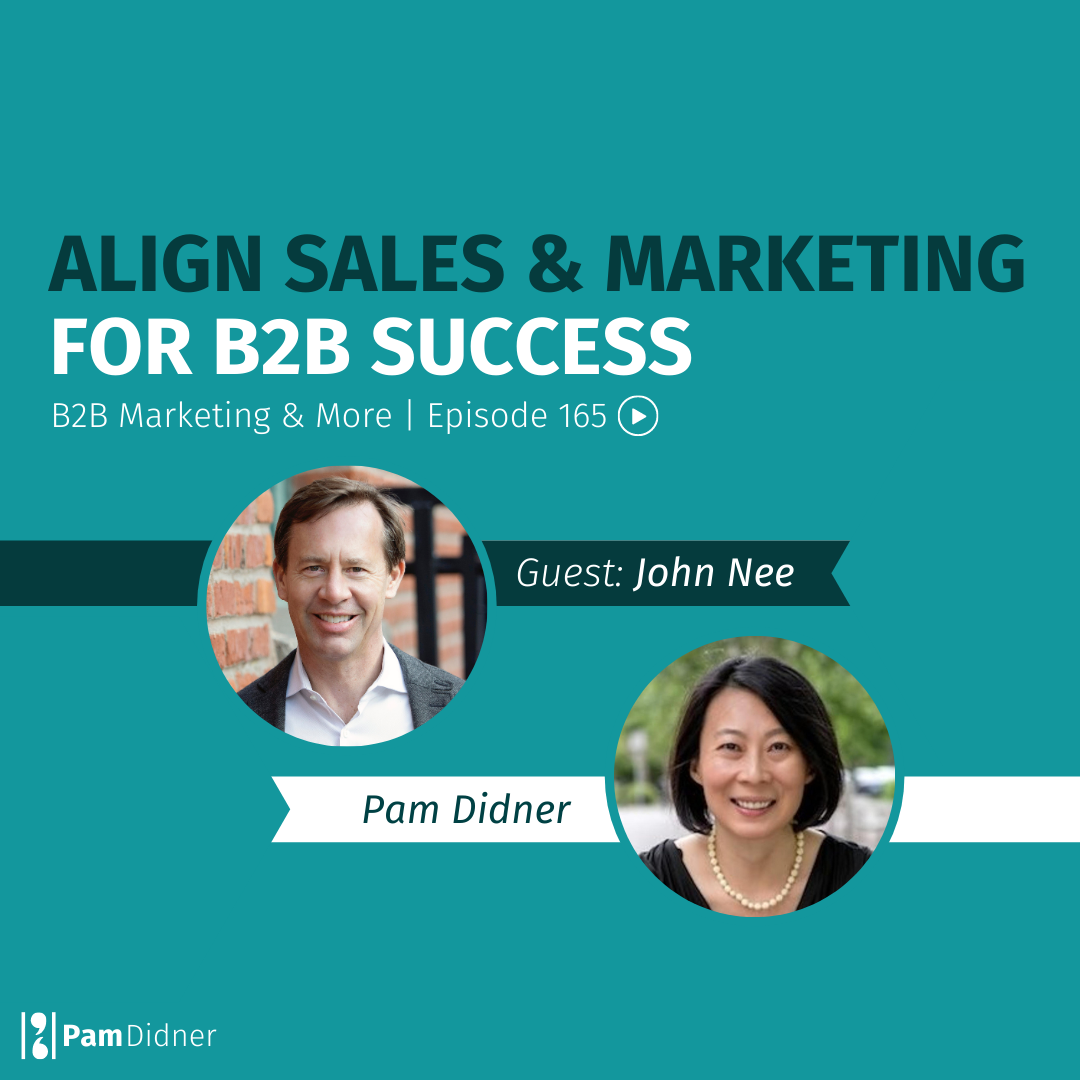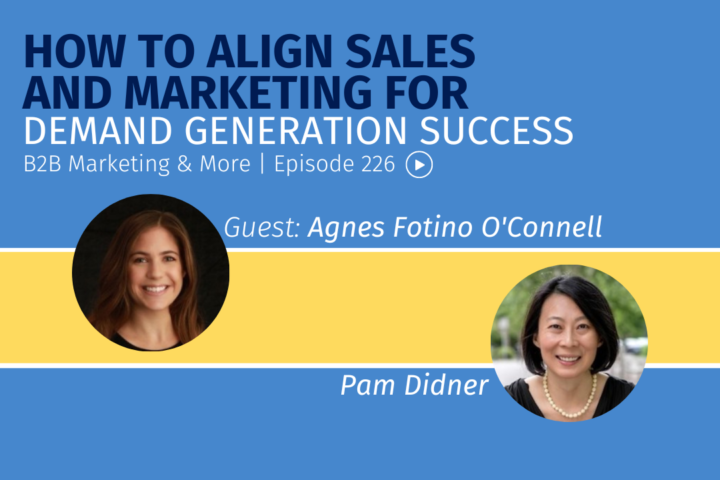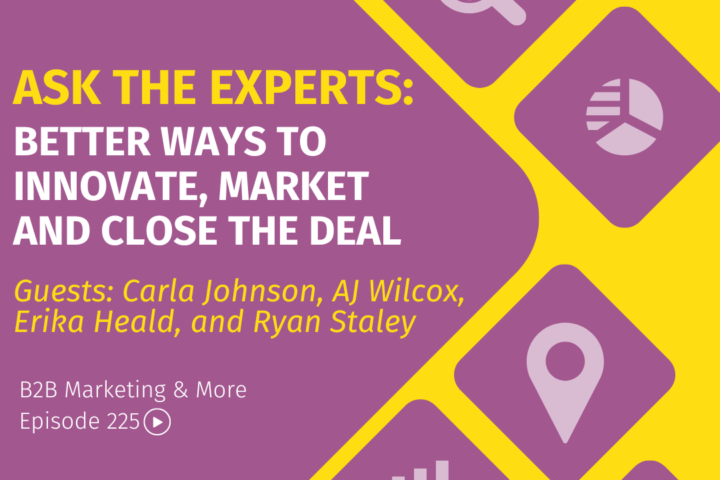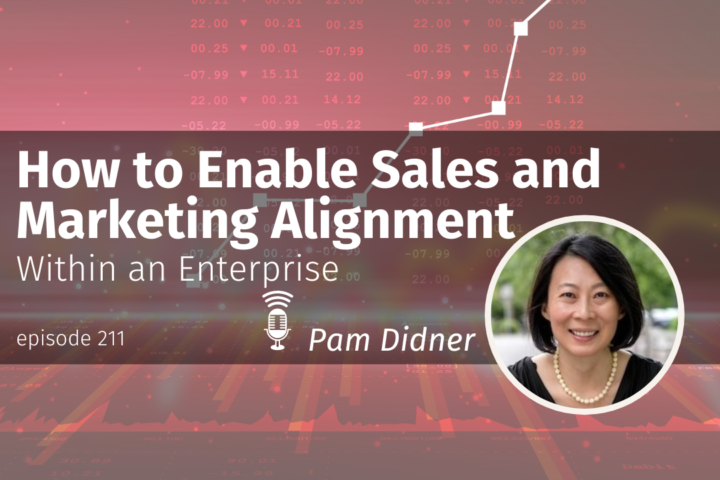
A big hello from Portland, Oregon! Today, I have an excellent guest, John Nee, the President and the Principal of Act 1 Partners.
With over 20 years of success as a marketing executive and business leader for fast-growing companies, John founded Act 1 Partners, a strategic marketing and experiential firm. The company is based in Portland, Oregon, and they have clients nationwide. They help businesses know their market, tell their story and live their brand through many different modules that they have primarily based around branding and strategy.
Today, we will discuss my favorite topic, sales enablement, and the marketing and sales alignment.
In this episode:
- Why is it so essential for B2B marketers to work with sales?
- What is the one thing marketers must do when they engage with a sales organization?
- What are the challenges of marketing and sales alignment, and what marketers can do to improve the collaboration?
- How can marketers improve the collaboration with sales, even change salespeople’s behaviour?
- What can help marketers to understand what they can do to assist the sales team better?
- With everything being digital, where is the handoff between marketing and sales now?
- What is the role of technology in supporting sales?
- What are some low hanging fruits that marketers can do to support sales?
- In what ways a product affects marketing and sales alignment?
Quotes from the episode:
“Good salespeople are the ones who are open-minded and are willing to learn and try new things. It also pays to have some successful salespeople who have relied on the marketing materials or marketing campaigns to be successful.”
“Although marketing automation tools are very powerful and critical for what marketing needs to promote the brand and build awareness and generate demand, that handoff between the leads that come in through marketing automation and how they’re managed in a CRM is critical. ”
—————
Enjoy the podcast? Subscribe to the show on your favorite podcast platform, leave a 5-star review and subscribe to Apple Podcasts.
If you prefer watching a video, I also have a YouTube Channel; check it out and subscribe.
If you want to chat, reach out to any social media channels or email me hello@pamdidner.com. You can also join my Facebook community: Build Your Marketing Skills to Get Ahead. When you join, you get a free Starbucks on me. You can go to the Announcement tab and click on the barcode of the gift card.
To expand your knowledge about marketing and sales alignment for B2B success, check out some of my previous podcast episodes and blog posts.
The Ultimate Sales Enablement Guide
Southwest Airlines Secret to Strong Sales Enablement Group
Does My B2B Company Need a Sales Enablement Team?
How Sales Enablement Benefits Marketing
TRANSCRIPT
I have an excellent guest today, John Nee, the President and the Principal of Act 1 Partners, and we will be talking about my favorite topic, sales enablement, and the marketing and sales alignment.
So, hi, John, welcome to the show.
John Nee: Hi Pam. Thanks for having me delighted to be here today.
Pam Didner: Excellent. So I didn’t go into detail to talk about, you know, what you do and also what your company offers.
So can you spend a couple of minutes with us and tell us why you do and a little bit about your company?
John Nee: Sure, you bet. Act 1 Partners is a strategic marketing and experiential firm. We’re based here in Portland, Oregon, but we have clients nationwide. And what we do is we help businesses know their market, tell their story and live their brand. And we do that through several different modules that we have largely based around branding and strategy. But we also feel companies need to have their workforce engaged in delivering the brand experience they want to deliver to the marketplace.
And that’s where the experiential element plays. Whether it’s the customer experience or employee experience, we are looking for that engagement among the workforce and customer loyalty.
Pam Didner: Wonderful. So you were talking about the employees’ engagement.
One organization that can engage with marketing extensively is the sales force, the sales team, or the sales organization within the company. So can you share with us why it is so important for B2B marketers to work with sales?
John Nee: Well, that’s a great question, Pam. And after almost 20 years of being a vice president or CMO for much different technology and telecom companies, I started this firm, Act 1 Partners, to help companies align their sales and marketing teams. I know firsthand the power of having sales and marketing teams aligned and the results generated when those two teams and departments work well together. And I also know how well of an impact it can have on the brand in the marketplace to have an engaged workforce. Whether that’s your sales force or your customer service force, or throughout the organization, the ultimate effect is that synergy between sales, marketing, the workforce, and how it transfers to a superior customer experience.
Pam Didner: So what is the one thing, from your perspective, the marketer must do when they engage with sales organization?
John Nee: I think the single greatest thing they can do is try to put themselves in the shoes of the salesperson. And I don’t think there’s any better way to do that than to go on sales calls. Do some ride-along sales calls, get on conference calls in this virtual world that we now live in and engage as much as possible with the customer and the prospect to learn how that sale happens. Because through that process, a marketer can then empathize with the salesperson and their needs and help create a campaign or help create sales tools that can empower the salesperson to do their job more effectively.
Pam Didner: That’s a great answer. And I suggest at my workshops all the time – have the marketers tag along with the salespeople or even the 10 DIA a huddles meeting or a sales call. But I got some feedback from time to time from marketers that their sales team don’t want them to be there. What is your recommendation or suggestion in terms of what they do to change that?
John Nee: Well, I think there’s a couple of things. I’d want to unpack why they wouldn’t want the marketing people to join them.
I think there is a level of respect that needs to be earned by marketing for sales.
Pam Didner: I agree with that, yeah.
John Nee: I also think, particularly on the product marketing side, it helps to tie compensation with the product’s success.
Pam Didner: Are you talking about the marketer should take on the incentive as well? Is that the point?
John Nee: The marketer, I think the product marketing, in particular, should have a bonus or some sort of compensation tied to the success of that product being sold. And it’s not uncommon for product marketers to have a bonus or some sort of compensation tied to the success of that product. And I think that will again allow them to better understand the customer’s demands, challenges in the marketplace of moving that product in the market.
Pam Didner: Yeah, but I agree with you that marketers need to earn salespeople’s respect. Using myself as an example, I’ve worked with the sales team for 10, 15 years. I remember when I started (laughs) when I talked to my salespeople, and I said, “Hey, can I join the call?” And they say, “no.” And, um, in general, when they say no, you need to think about in terms of why you can offer. You know, why can you provide value to them and see that you provide value, so you can tag along to a sales call.
Over some time, I could share marketing campaigns or even co-marketing ideas that they can use with them.
Or even share some of the content that we created on the marketing side, but structured in a way they understand and then share with the salespeople and tell them that, you know, how they can use some of the content that we created.
But I do agree with you in terms of you have to earn their respect. Yeah.
John Nee: Right.
Pam Didner: Um, another thing. I got constant feedback because many marketers have told me that it is challenging to make sales change their behaviors. And this is true, especially in digital marketing. A lot of time, when we do digital marketing, it’s no longer marketer’s job to do marketing outreach. And the sales also need to learn how to use, say, you know, social media to do some social selling. But it’s very, very difficult to change or modify their behavior. What is your thought to help the marketers understand what they can do to help the sales team better?
John Nee: Yeah, that is a real challenge. And I think the good salespeople are the ones who are open-minded and are willing to learn and try new things.
It also pays to have some successful salespeople who have relied on the marketing materials or marketing campaigns to be successful. And use that as an internal case study to illustrate to the other salespeople how these marketing tools and how marketing campaigns can help them, uh, close more business.
As I’m sure you probably know, many of us now have realized that marketing over the last 20 years has grown deeper and deeper into the classic sales funnel.
Pam Didner: Yeah.
John Nee: And now with, obviously it’s not new anymore, but customers now with the internet can do a lot of their research independently. Often, it’s them reaching out to the salespeople with a decision they’ve already made. And it’s the sales person’s job to either convince them further and close the deal or if the salesperson is in discussions with them, try to convince them that the competitor information, um, maybe is, is not as good as the, um, as it was the service that they’re selling.
So that’s, that’s the challenge is where’s that handoff between marketing and sales now?
It’s deeper into the classic sales funnel than it used to be, but we still need each other. Right. We still need that partnership still needs to exist marketing, unless it’s an e-commerce sale, marketing really can’t close the deal. Most of my experience is with more of a consultative sale and the B2B and telecom technology space, not transactional purchases.
Pam Didner: And also, the purchasing cycle is so much longer.
John Nee: It’s longer. That’s right. That’s right. So we still need each other, but it’s a, it’s a little bit of a different handoff than what it used to be.
Pam Didner: I agree with the handoff between sales and marketing, especially in the digital world. And, um, I also, uh, agree with you in terms of your sentiment or assessment that marketing is actually moving deeper down into the sales funnel and then provide that help or extra lift for the sales team.
The thing about changing salespeople’s behavior, what I have found is, um, it’s hard to do, but usually, I try to do a top-down, like go directly to a VP of sales and explain the challenges I encounter. Not necessarily they care (laughs).
I tried to quantify that they need to change their behavior to impact the sales revenue.
And, uh, another thing I usually suggest to the people who attend my workshop, is it possible to tie some of the key initiatives or the tool they need to use with the, uh, bonuses?
In general, when you have a certain kind of a bonus is tied with certain kind of behavioral changes that tend to add a little incentive, if you will, to kind of motivate them to change their behavior. But that not necessarily thing that’s, you know, sustainable. Right. But that’s one approach I have tried. And, uh, but as I said, the salespeople tend to scream and kick the whole time (laughs).
John Nee: Right. Right. Well, you know, and there’s, there’s maybe some fun ways to do that, too. For instance, we often run contests purely based on activity, not necessarily on results. Even if you have a sales force of a hundred different sales reps, direct sales reps, maybe stack ranks them as to how many pieces of marketing literature were downloaded in a particular month. To have a contest to how many and how many sales calls were made and publicize that. These are very competitive people by nature. Simply highlighting the activity metrics and not so much the results – because we know activity ultimately will drive the results – but focusing more on the activity and making it a fun gamification typesetting could also change some behaviors.
Pam Didner: I like that suggestion a lot. I liked that. Well, that’s changed the topic a little bit.
Let’s talk about the MarTech and sales tech, and obviously, marketing’s centerpiece is always about marketing automation tools.
Right? So if we do marketing, there’s always a marketing automation tool as our baseline, and then sales tend to be the CRM. Is it necessary to integrate these two tools? And how important is that? And should marketers know the CRM tool well to support sales? Do you think that’s a requirement?
John Nee: I do. I do. It’s critical that those two systems talk to each other. And again, it goes back to that handoff. And it also is critically important in account management or customer care environment beyond the new logo sale or the new customer onboarding. When we’re prospecting for new business, it’s also critical for the account management portion of the relationship.
Although marketing automation tools are very powerful and critical for what marketing needs to promote the brand and build awareness and generate demand, handoff between the leads that come in through marketing automation and how they’re managed in a CRM is critical. And that’s why I think it’s important for marketing professionals to also understand the CRM system intimately and how to use that and how salespeople use it, have their dashboard and become very familiar with how that lead will be worked on.
It’s not. I think a secret is that salespeople’s turnover will be more frequent than it is for marketing and even account management.
And so that’s that continuity of knowledge that the marketing team has on the CRM, on how marketing automation talks to the CRM is critical.
Pam Didner: And especially if you want to track from MQL to SQL and SQL to a qualified lead and a qualified prospect down to like the deal loss and deal, uh, one, uh, you want to try call that prospect going through that journey is very critical to have two tools integrated.
John Nee: Right.
Pam D: In my, uh, workshop, I continuously emphasize they also need to know the CRM tool. It’s not necessarily how to use the CRM tools inside and out. It’s more or less understand the dashboard. Understand the dashboard, uh, generated from CRM, understand how those dashboards are calculated and, uh, for example, deal lost. What are some of the causes to engender on the deal lost and understand that and the diving a little more detailed to understand the data behind the scenes.
John Nee: It’s a data discussion, which is why the other party that’s important to this discussion is your information technology group.
How does IT, managing their company tech stack, and how does a MarTech stack fit into that strategy?
Pam Didner: I mean, that is such a complex topic, especially the Martech stack, and every company does the Martech stack differently, and they all use different tools. I know it’s very hard for marketers to untangle all the tools out there. Still, from my perspective, it is very important to understand sales funnels, what tools are used and how they are used by the sales and marketing professional, so you can have a holistic view of how marketing runs within an organization.
John Nee: Right. That’s right.
Pam Didner: Yeah. So, uh, what are any low hanging fruit that marketers can do to support sales?
John Nee: Well, I think there’s no single greatest thing that marketing can do for sales other than providing leads.
Even if they’re not maybe as qualified a lead as they would like, it’s a great start to begin having the discussion, providing some immediate value to the salesperson and then tracking that lead to revenue or disqualifying or qualifying the lead. Maybe it was a qualified marketing lead, like you said, an MQL, but it didn’t qualify as a sales lead and determining why that is.
So I think just having leads start with provides a framework for some good discussion between marketing and sales as to what, what are we looking for from these leads? Are we targeting the right segment of the market? Are we asking the right questions? Is there information we can learn about these leads that are automated? What if we can tie that lead to a dataset or something in the marketplace that can help us pre-qualify this lead, so it’s not as much work manual work to qualify the lead going forward. So those are the kinds of discussions and rich opportunities. I think that marketing and sales can have some profound discussions on how marketing can support sales.
Pam Didner: I agree with you. You mentioned the most immediate needs that sales, um, would like to get from my, uh, from marketers is lead gens. If we can generate some leads for them. And, uh, you mentioned that it doesn’t initially.
It doesn’t have to be high-quality leads, but started somewhere and have that in-depth conversation or continuous conversation with your sales team.
John Nee: Yeah, it’s the classic perfection can be the enemy of excellence. Right. And if you’re waiting and waiting until you got a perfect campaign that can bring in the perfect lead, you may not get any leads or maybe too late. So some leads, at least early on, are better than no leads.
Pam Didner: Yep. Just try to get started. Test the water and optimize as you go.
John Nee: That’s right.
Pam Didner: So sales and marketing alignment is a journey. And, uh, so you mentioned your experience working with multiple telecom companies. And so, looking back on your journeys, what are the two things that you wish you had done differently?
John Nee: Well, that’s that’s a really interesting question. There’s a lot of things I think I would do differently.
One of the things that I learned, one of the things that I learned is just the importance of product for the success of marketing. And like many of us already know, the product is one of the four classic Ps of marketing. And I think we must be part of that discussion because product drives so much of the customer experience provides. It provides a great way to discuss whether or not we’re targeting the right segment of the market. And why are we targeting that segment of the market? Is this a segment that needs this product?
And so it goes back to discovering what a company’s, which would probably be the second thing that I would do differently, is getting leadership together as early on as possible. Long before we start putting pen to paper on strategy or any kind of plans, budget, and take the time to collectively agree that there’s a common consensus as to what the company’s why is, you know, why this company is in business? Who are we serving? What products are we delivering to them?
Pam Didner: I do agree with you in terms of it. It’s kind of like moving marketing upstream.
And a lot of time, uh, marketing is, tend to be the bottom of the barrel and the products are done. And then the messages are done. The feature is already said, “okay, marketing goal, market the product.” And you brought up a very nice insight in terms of the marketers needs to be actively involved, uh, in the early product development discussion. And possibly sharing marketing research, or even bringing some user insight information as a part of the product development, understand the product so much better. That will help in terms of messaging and talking point development. I like that a lot.
I think most marketers are not doing that, to be honest with you. And that has a lot to do with our job scope. And our job scope is email marketing. Our job scope is, uh, event marketings. Our job scopes are, you know, digital marketing or even social media. So it doesn’t give us that opportunity to work with the product team as extensively as we wish we could. But, uh, I agree with you that having that experience help and can broaden a marketer’s horizon.
And another thing I liked that is you brought up a very good point, and I talk about it on many occasions – strategic thinking.
We’re all doing a lot of tactics, and, uh, to ask why and be strategic about it, I think that’s one of the key essential skillets that the marketer needs to acquire.
So this is good, and it’s great. Great conversation. And I do. I will like to ask you one silly question. So what is the most useless talent that you possess? (laugh) Like people will look at and say, “okay, John, that, that, that, that that’s cool.” But you provide no value whatsoever to society.
John Nee: Well, I’m, I’m trying to learn guitar, so I don’t know if that’s a useless talent or not, but that’s kind of like my latest, uh, distraction and preoccupation, especially during the pandemic. So, uh, I don’t think, I don’t think there’s any real direct benefit.
Pam Didner: Is that a 2021 new year’s resolution?
John Nee: I don’t think there’s any direct benefit of guitar playing or at least the novice guitar playing to being a marketing professional and marketing leader, but it’s what comes to mind at least.
Pam Didner: Oh, very good. So it’s a bass guitar, electric guitar or just regular guitar?
John Nee: It’s just classical six-string acoustic guitar.
Pam Didner: Oh, wonderful.
John Nee: Nothing, nothing too fancy.
Pam Didner: All right. Maybe next time you can make the intro, my intro music for me.
John Nee: It would be a long time before that happens. (Pam laughs)
Pam Didner: Fantastic. And thank you, John, so much for joining us and so happy. So happy to have you on my show.



